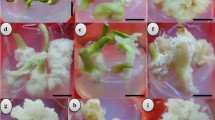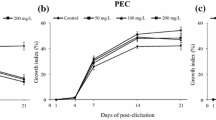Abstract
When growth-phase cell suspension cultures of Capsicum annuum were treated with cellulase-elicitor preparation at 3 μg/ml, the level of capsidiol was transiently increased in the culture media rather than in the cells reaching its maximum approx 24 h after treatment. With methyl jasmonate it took 18 h. Elicitor treatment doubled phospholiphase A2 (PLA2) activity but simultaneous treatment with aristolochic acid, a PLA2 inhibitor, inhibited sesquiterpenoid accumulation as well as PLA2 activity. Mastoparan, a G protein activator, treatment also increased PLA2 activity and capsidiol production. Taken together, the present study shows that induction of capsidiol production in the C. annuum is mediated by PLA2 activation.



Similar content being viewed by others
References
Blechert S, Brodschelm W, Holder S, Kamerer L, Tutchan TM, Mueller MJ, Xia Z, Zenk MH (1995) The octadecanoic pathway: signal molecules for the regulation of secondary pathways. Proc Natl Acad Sci USA 92:4099–4105
De Marino S, Borbone N, Gala F, Zollo F, Fico G, Pagiotti R, Iorizzi M (2006) New constituents of sweet Capsicum annuum L. fruits and evaluation of their biological activity. J Agric Food Chem 54:7508–7516
Hano C, Addi M, Bensaddek L, Cronier D, Baltora-Rosset S, Doussot J, Maury S, Mesnard F, Chabbert B, Hawkins S, Laine E, Lamblin F (2005) Differential accumulation of monolignol-derived compounds in elicited flax (Linum usitatissimum) cell suspension cultures. Planta 16:1–1
Higashijima T, Uzu S, Nakajima T, Ross EM (1988) Mastoparan, a peptide toxin from wasp venom, mimics receptors by activating GTP-binding regulatory proteins (G proteins). J Biol Chem 263:6491–6494
Jung KM, Kim DK (2000) Purification and characterization of a membrane-associated 48-kilodalton phospholipase A2 in leaves of broad bean. Plant Physiol 123:1057–1067
Kim BJ, Gibson DM, Schuler ML (2005) Relationship of viability and apoptosis to taxol production in Taxus sp. suspension cultures elicited with methyl jasmonate. Biotechnol Prog 21:700–707
Kim DK, Lee HJ, Lee Y (1994) Detection of two phospholipase A2 activities in leaves of higher plant Vicia faba and comparison with mammalian PLA2’s. FEBS Lett 343:213–218
Mandujano-Chavez A, Schoenbeck MA, Ralston LF, Lozoya-Gloria E, Chappell J (2000) Differential induction of sesquiterpene metabolism in tobacco cell suspension cultures by methyl jasmonate and fungal elicitor. Arch Biochem Biophys 381:285–294
Nashiri A, Holth A, Bjork L (1993) Effects of sesquiterpene capsidiol on isolated guinea-pig ileum and trachea, and on prostaglandin synthesis in vitro. Planta Med 59:203–206
Saito S, Okamoto M, Shinoda S, Kushiro T, Koshiba T, Kamiya Y, Hirai N, Todoroki Y, Sakata K, Nambara E, Mizutani M (2006) A plant growth retardant, uniconazole, is a potent inhibitor of ABA catabolism in Arabidopsis. Biosci Biotechnol Biochem 70:1731–1739
Schweizer P, Buchala A, Silverman P, Seskar M, Raskin I, Metraux JP (1997) Jasmonate-inducible genes are activated in rice by pathogen attack without a concomitant increase in endogenous jasmonic acid levels. Plant Physiol 114:79–88
Stillman MJ, Stothers JB, Stoessl A (1981) Carbon-13 NMR studies. 95. postinfectional inhibitors from plants. XXXIX. Capsidiol and 1-epicapsidiol: absolute configuration, NMR, and optical spectra of the dibenzoates. Can J Chem 59:2303–2305
Vogeli U, Chappell J (1990) Regulation of a sesquiterpene cyclase in cellulase-treated tobacco cell suspension cultures. Plant Physiol 94:1860–1866
Whitehead IM, Threlfall DR, Ewing DF (1987) Cis-9,10-dihydro-capsenone: a possible catabolite of capsidiol from cell suspension culture of Capsicum annuum. Phytochemistry 26:1367–1369
Yoon HJ, Kim HK, Ma CJ, Huh H (2000) Induced accumulation of triterpenoids in Scutellaria baicalensis suspension cultures using a yeast elicitor. Biotech Lett 22:1071–1075
Zhao Y, Schenk DJ, Takahashi S, Chappell J. Coates RM (2004) Eremophilane sesquiterpenes from capsidiol. J Org Chem 69:7428–7435
Author information
Authors and Affiliations
Corresponding author
Rights and permissions
About this article
Cite this article
Ma, C.J. Cellulase elicitor induced accumulation of capsidiol in Capsicum annumm L. suspension cultures. Biotechnol Lett 30, 961–965 (2008). https://doi.org/10.1007/s10529-007-9624-y
Received:
Revised:
Accepted:
Published:
Issue Date:
DOI: https://doi.org/10.1007/s10529-007-9624-y




